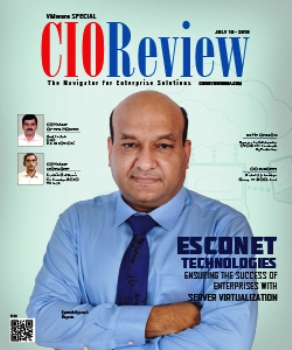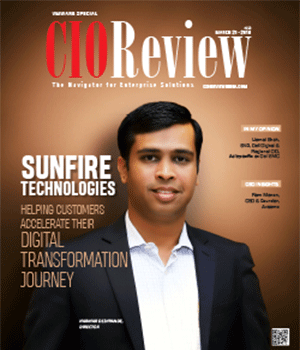
VMware Delivers Innovations to the Digital Workspace with Unified Endpoint Management, Windows 10 Support and Enhanced Identity Management
CIOReview Team | Friday, 02 September 2016, 04:49 IST
 VMware, Inc. (NYSE: VMW) has announced a new unified endpoint management approach for managing Windows 10, along with advancements to VMware Horizon® and VMware Workspace™ ONE™. These innovations help advance the digital workspace embraced by the industry and solve the challenge of supporting an increasingly mobile workforce that demands anytime, anywhere access to all applications from any device.
VMware, Inc. (NYSE: VMW) has announced a new unified endpoint management approach for managing Windows 10, along with advancements to VMware Horizon® and VMware Workspace™ ONE™. These innovations help advance the digital workspace embraced by the industry and solve the challenge of supporting an increasingly mobile workforce that demands anytime, anywhere access to all applications from any device.
The evolution of client-server applications to cloud and mobile applications is challenging businesses everywhere. With the added complication of the consumerization of endpoints, companies are adopting digital workspaces for a simplified approach to managing, delivering and consuming applications from the cloud. Using the principles of consumer simple and enterprise secure, the digital workspace delivered by VMware aggregates all devices, applications and services while securely managing them through unified common access and identity. With businesses transitioning to Windows 10 and its mobile focused platform, the challenge of scaling Windows 10 desktops and applications, supporting legacy applications, and integrating an ever-expanding ecosystem of mobile applications used by mobile devices, will further the need for a secure digital workspace as the solution.
“We believe there is an incredible opportunity to push identity-driven secure digital workspaces for the delivery of any app on any device, especially as businesses shift to Windows 10 and increasingly offer cloud-based productivity suites such as Office 365 to employees,” said Sanjay Poonen, executive vice president and general manager, End-User Computing and head of global marketing and communications, VMware. “VMware’s digital workspace uses industry-leading technology from AirWatch® and Horizon, coupled with identity management, and can immediately help solve fundamental challenges businesses face today like deploying Windows 10. In addition, we are also planning the next phase of the digital workspace to fundamentally change the endpoint management paradigm.”
Modern Approach to Unified Endpoint Management for Windows 10
Industry analyst firm Gartner reports that, “The future of endpoint management lies in consolidation of management tools that manage traditional PCs and mobile devices as a common management framework evolves across the two.”
Legacy on-premises models for endpoint management are difficult with disjointed management and complex processes designed for fixed desktops and client-server applications. With PCs increasingly used outside of the corporate network and accessing cloud services, businesses need a modern, solution suited for the mobile-cloud era. Representing the next phase of the digital workspace, new technology from VMware will offer comprehensive unified endpoint management and security technology for mobile and desktop management. The technology extends current Windows 10 management with PC lifecycle
management capabilities including configuration management and provisioning, software distribution, operating system (OS) patch management and client health and security management, to fundamentally change the endpoint management paradigm using a modern, mobile-cloud platform. This enables IT to deploy security patches and OS updates faster, install software more reliably and consolidate operational processes across all devices – on or off the domain. By integrating PC lifecycle management with modern enterprise mobility management (EMM), the VMware unified endpoint management technology can lower the cost of managing Windows deployments, secure endpoints and data on any network across any application, and deliver a high quality consistent experience to end-users across any device.
"Customers say that managing multiple consoles for all their endpoint solutions is getting more cumbersome by the day,” said Orion Hindawi, cofounder and CEO, Tanium. “They need a streamlined solution that takes into account things like cloud, virtualization, mobility and the increased scale those changes have driven. They need less complexity to do more good work."
For more information on the development and benefits of the technology, visit the VMware UEM microsite and attend Connect Atlanta.
VMware Horizon: Accelerating Performance with Up to 6X Reduction of Bandwidth
As workforces become increasingly digital, VMware Horizon enables companies to provide access to personalized desktops and applications anytime, anywhere using a digital workspace. Designed for the mobile-cloud era, with a focus on helping customers drive down the cost and complexity of managing and delivering applications and desktops, new innovations and an expanded partner ecosystem of VMware validated solutions extend the breadth and scope of VMware Horizon to support customers of all sizes.
Key highlights to the VMware Horizon enhancements include:
– Enhanced Features in Blast – The VMware Blast Extreme™ protocol will provide increased performance with up to a 6x reduction in image bandwidth consumption and a 15 percent reduction in audio streaming to deliver a rich experience for end-users consuming virtual Windows applications and desktops. New support for Riverbed technology in Horizon 7 will increase access speeds for end-users on wide area networks (WAN) and 3D graphics applications with Horizon 7 will see up to a 24 millisecond latency reduction when used with NVIDIA GRID. Lastly, Horizon 7 will offer support for the Swiftpoint mouse when consuming virtual desktops and applications on iPads and other iOS devices.
– High Performance Affordable Devices – An expanding list of Blast-enabled devices will include new validated thin and zero clients from Dell, HP and iGEL, along with the technology preview of support for Raspberry Pi. This will provide customers the flexibility to use Blast to deliver high quality Horizon 7 or Horizon Air desktops and applications using affordable hardware to lower the overall cost of providing and managing enterprise desktops.
– Cloud Managed Plug-and-Play Appliances – New validated appliances for Horizon Air™ Hybrid Mode from Dell, EMC, Hitachi Data Systems and QCT will support the rapid setup and delivery of virtual desktops and applications. Horizon Air provides full lifecycle management of the desktops and applications from the cloud, significantly minimizing provisioning, setup and configuration time and enabling automatic cloud-driven updates.
Companies of all sizes can use VMware Horizon to support a mobile workforce and simplify desktop and application management through a digital workspace. For a complete list of features and benefits available in Horizon, visit the VMware End-User Computing blog.
“At Sprint, we wanted our employees to be more productive and effective so we worked closely with VMware to offer access to the applications, tools and resources they need from the cloud across any device,” said Joe Hamblin, director of emerging technology, Sprint. “We were also looking for cost-savings through the use of affordable endpoint devices and a modern cloud-based architecture for applications and desktop delivery that would enable our small IT team to support our employees. VMware Horizon Air is helping us to achieve those goals, along with a great experience for our end-users.”
VMware Workspace ONE: Automated Provisioning for Office 365 and Consumer-Simple Registration
Workspace ONE with VMware Identity Manager™ helps customers overcome the deployment and management challenges of Office 365. Enhancements to the solution will enable administrators to automatically provision and de-provision end users based on existing active directory group membership. When employees leave an organization, access to cloud-based Office 365 resources is immediately revoked through entitlement management, whereas previously authentication tokens could be valid for hours or days after separation. Updates to the VMware Verify mobile push-application will also offer a consumer-simple registration workflow that eliminates the need for end-users to download and register a two-factor authentication (2FA) application.
CIO Viewpoint
The 3 Biggest Challenges of Managing...
By Saunak Ranjitkar, CIO / Chief Software Architect, Spiralogics
IT Strategy Needs Frequent Updates
By Sankaranarayanan Raghavan, Director - IT, AEGON Religare Life Insurance
Opportunities for Integration and Innovation
By Nicholas J. Smither, Group VP & CIO, Ford
CXO Insights
Embedding Security as a part of SDN system
By Subhasish Gupta, Country Manager - India & SAARC , Allied Telesis
How Not to Automate Your Business
By Bharat Krishnamurthy, VP Applications Delivery, Exide Life Insurance
Simplicity-The Virtue Of Future Security Solutions








